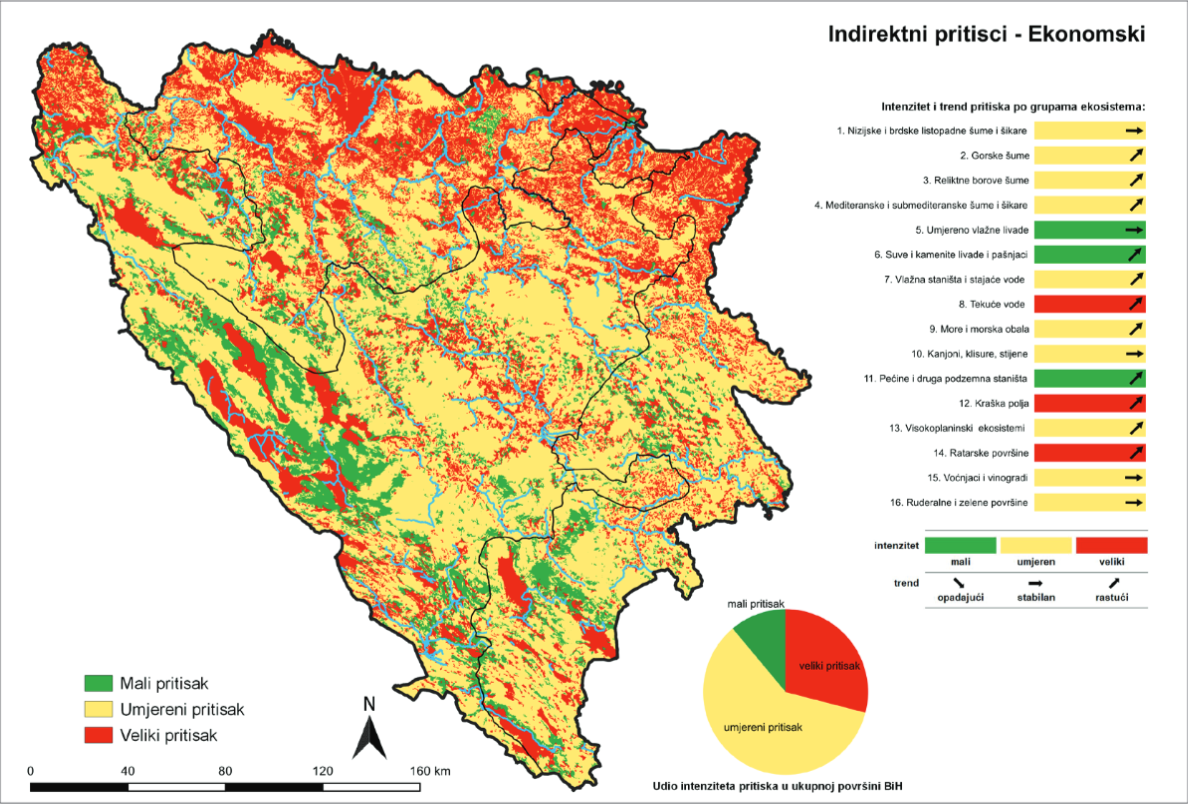Pressures upon nature in Bosnia and Herzegovina: Assessment of their status and trends by groups of ecosystems
DOI:
https://doi.org/10.7251/GSF2232003SKeywords:
Bosnia and Herzegovina, groups of ecosystems, pressures on nature, status and trendsAbstract
Increasing drivers (i.e. pressures) on nature are present at the global scale, resulting in the upgrowth of the number of endangered species and habitats, as well as a decrease in the capacity of ecosystems to provide various benefits to the human population. Recent studies indicate that natural ecosystems are frequently unable to adequately and efficiently provide the flow of ecosystem services or nature’s contribution to people (i.e. NCP), emphasising that this negative trend will continue in the future. These trends can be linked with the existence of drivers or pressures on nature, which are numerous and have an increasing trend over time. Pressures on nature are all changes and disturbances in the functioning of biological processes and systems, followed by disruption of the ecosystem structure and the integration of the living world. In order to prevent the loss of biodiversity and ensure NCP, it is important to recognize and understand direct and indirect pressures on nature. In this sense, this paper presents the spatial distribution, intensity, trends and drivers of individual categories of pressures on nature in Bosnia and Herzegovina, as well as their combined effect. The presentation of pressures on nature is based on 16 broadly recognizable groups of ecosystems that include broad natural units (e.g. high mountain complexes), or a complex of ecological factors (e.g. dry and rocky meadows and pastures), the dominant type of use (e.g. agricultural areas) or the dominant type of pressures (e.g. urban areas) (Figures 2 and 3, Table 1). For the purposes of assessing the intensity of certain categories of pressures (direct and indirect) and their trends per ecosystem groups, an expert assessment procedure was carried out, using a structured research instrument, that enabled the analysis of experts’ views when it comes to the intensity and trend of certain categories of pressures for each ecosystem group (Tables 2 and 3). The results of this research indicate that the urban ecosystems, running water ecosystems and agricultural ecosystems are under the highest pressure, while the lowest pressures are associated with the underground and canyon ecosystems (Figures 4–13, 16). Direct pressures are generally rated as more intense than indirect pressures (Figures 14 and 15). For the majority of analysed direct and indirect pressures, similar effects and trends are confirmed as at the global level. According to the opinion of the experts, who participated in this research, overuse and pollution were assessed as the highest direct pressures on nature in Bosnia and Herzegovina, while institutional pressure was recognised as the highest indirect pressure. Keeping in mind that, according to their characteristics, institutional pressures are inseparable from the state authority and its institutions while, in the context of Bosnia and Herzegovina, they are inevitably linked to the socio-political organization and numerous criticisms of the (non)functioning of institutions. Groups of ecosystems with a significant share in total area (e.g. arable land, lowland and mountain deciduous forests and shrubs, etc.) are also characterized by high pressure with a moderate or increasing trend. Although competent institutions in Bosnia and Herzegovina participated in various international processes, systemic and institutional activities that would result in the application of good practices of the international initiatives regarding nature protection and sustainable use of natural resources are often missing. In that sense, the results of this research provide the decision-makers and the scientific community with scientifically based arguments and overall directions for the decision-making process and conducting future research in the field of natural resources and their sustainable use.

Downloads
Published
Issue
Section
License
Copyright (c) 2022 Vladimir Stupar, Mersudin Avdibegović, Senka Barudanović, Josip Jurković, Sandra Kobajica, Milan Mataruga, Dženan Bećirović

This work is licensed under a Creative Commons Attribution 4.0 International License.